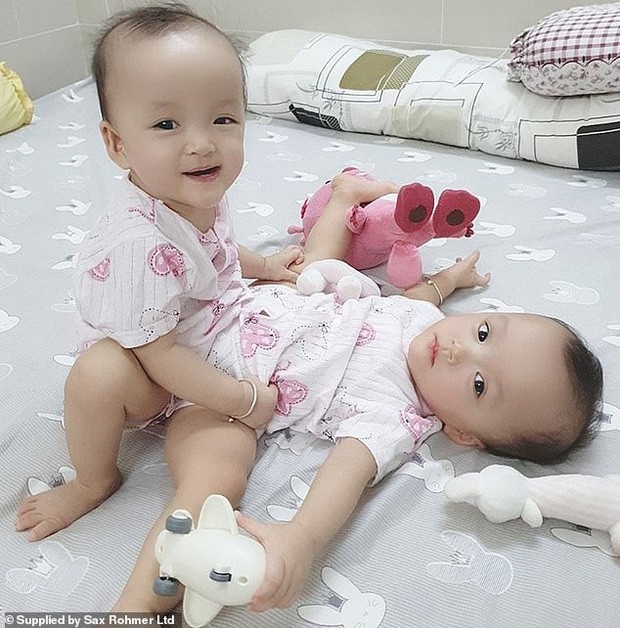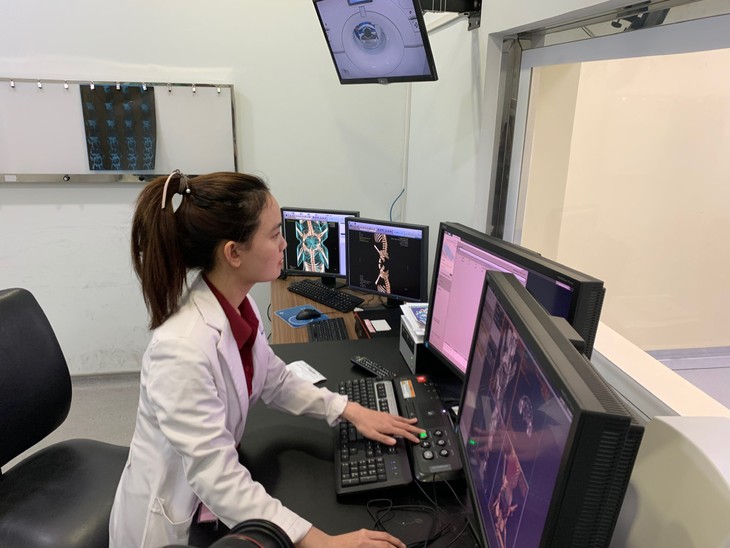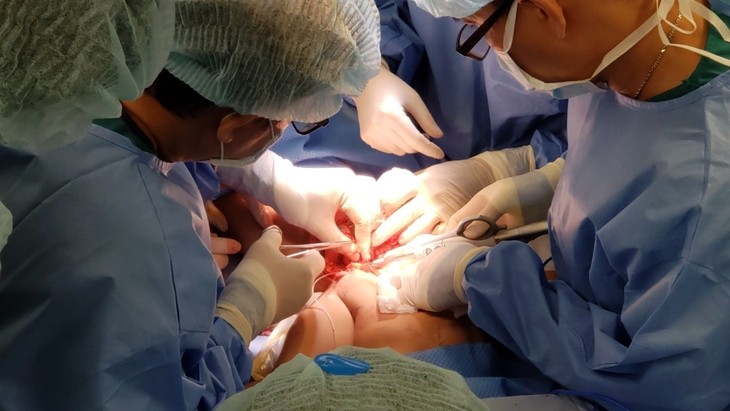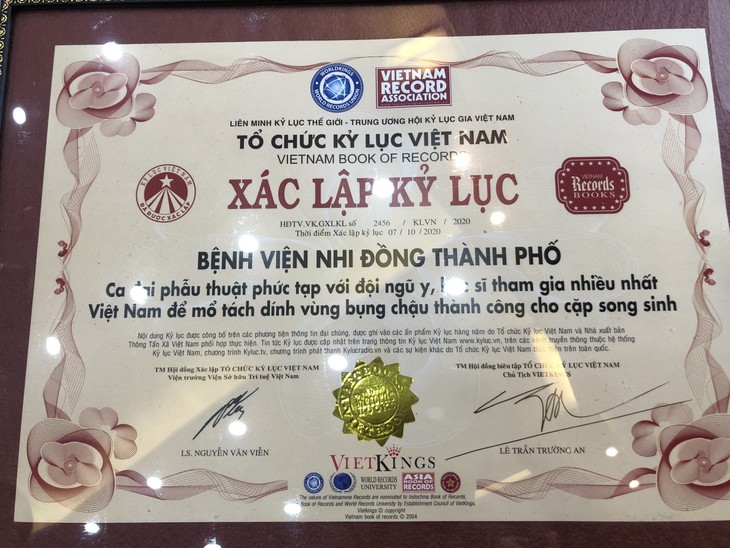 The twin before the grand operation (Photo: kenh14.vn) The twin before the grand operation (Photo: kenh14.vn) |
Hoang Truc Nhi and Hoang Dieu Nhi were born prematurely on June 7, 2019, conjoined at the pelvis. Truc Nhi and Dieu Nhi shared parts of their ileum and colons. They had two separate bladders and two ureters leading to them. Their pelvis was arranged in a circle. Over the past year the twins had learned to sit up and coordinate with each other to move around despite their condition. Conjoined twins occur roughly once in every 200 identical twin pregnancies. Only 6% of them have four separate legs, like Truc Nhi and Dieu Nhi.
Born at Hung Vuong Hospital, the twins were transferred to the HCMC Children’s Hospital to be raised and monitored. 29-year-old doctor Nguyen Ngoc Minh Khanh of the Department of Diagnostic Imaging has worked on their case since they were three months old. Khanh was in charge of analyzing images and providing consultation for the big surgery to separate the two babies. She was baffled when she saw the twins’ strange body structure for the first time. Khanh couldn’t help feeling shocked and sad as she couldn’t imagine how the two babies could live in symbiosis. The young doctor spent sleepless nights studying the films and X-rays of the twins, and used ultrasound to locate their bladder, uterus, and vagina.
After three major examinations, when the babies were three months, six months, and nine months old, Khanh was able to locate their liver, spleen, kidney, pancreas, bladder, and uterus, but how their blood vessels were arranged and how their intestine was joined remained unknown. Only after the fourth examination, one month before of the big surgery, when the two babies weighed 15 kilograms, did the doctors know their complete body structure. The surgeons spent ten months studying films, doing ultrasounds, and rendering 3D images of their intestine, bladder, kidney, and genitals. Doctor Khanh said, “Their blood vessels were extremely hard for us to separate. Diagnostic imaging took nine months, starting when when they were just three months old, to fully analyze their blood vessels.”
 Dr. Khanh renders 3D images of the conjoined twins' full body structure. (Photo: VOV) Dr. Khanh renders 3D images of the conjoined twins' full body structure. (Photo: VOV) |
On July 15, the grand operation took place in 13 hours and 40 minutes. The girls’ vital signs were stable. Days later, an ultrasound of their urinary system showed their uteruses and vaginas receiving good blood flow. Doctor Le Thanh Hung, Head of the Department of Urology and Nephrology of the Ho Chi Minh City Children’s Hospital, one of the chief surgeons, felt relieved and hopeful. Each of the two now has a normal uterus and vagina and should have normal reproductive function when they grow up. Although there is a long way to go on recovery and rehabilitation, the twins are improving day by day. Dr. Hung said he feels honored to have been part of this surgery. As leader of the team responsible for separating ureters, bladders, uteruses, and ovaries, Dr. Hung spent a lot of time figuring out how to cut the conjoined, mislocated organs precise to the millimetre.
He told VOV, “I felt very anxious and mentally pressured because this was an extraordinarily complicated operation. I mentally pictured cutting and relocating the ureters, bladders, uteruses, and ovaries and connecting them to other organs so they would function well after the operation.”
 The grand operation to separate Truc Nhi and Dieu Nhi takes place on July 15, 2020. (Photo: Ho Chi Minh City Children’s Hospital) The grand operation to separate Truc Nhi and Dieu Nhi takes place on July 15, 2020. (Photo: Ho Chi Minh City Children’s Hospital) |
According to Dr. Truong Quang Dinh, Director of the Ho Chi Minh City Children’s Hospital and leader of the operating team, at 13 months, the bones of Truc Nhi and Dieu Nhi began to harden, making it hard for the doctors to chisel the bones apart. But the operation was a success, thankfully.
Dr. Phan Van Tiep, who led the orthopedic surgery, said his team held planning sessions for months to work out primary and backup scenarios. The usual pelvic resection requires the patient to lie on one side so the doctors can see the pelvis clearly. But Truc Nhi and Dieu Nhi were supine so their pelvis was close to the operating table. Because it was so hard to make an accurate cut in their position, a special tool was designed specifically for this surgery. After their pelvis was cut, the two babies were transferred to another operating room. The six orthorpedic surgeons were divided into to two groups to close the two pelvises, while other doctors remade each girl’s anus and urethra.
Doctor Tiep said, “We knew if we couldn’t close the pelvis, to would not have enough skin to close the abdomen. This would be a big problem for the surgeons who worked on the kidneys and unirary trail. Those organs are really close to the perineum and are susceptible to infection if the skin is not closed. We struggled at first but managed it eventually.”
 The grand operation to separate Truc Nhi and Dieu Nhi takes place on July 15, 2020. (Photo: Ho Chi Minh City Children’s Hospital) The grand operation to separate Truc Nhi and Dieu Nhi takes place on July 15, 2020. (Photo: Ho Chi Minh City Children’s Hospital) |
One week after the separation, the two babies were conscious and smiling and could control their movements. One of the twins was taken off her ventilator. This has been a joyful event for the family, the post-operative care team, and the doctors who performed this historic surgery. Three months have gone by and the two babies are doing well.
In early October, the twins were strong enough to be discharged from the hospital. At their farewell ceremony, the girls were cheerful and playful while taking photos with the doctors. They could sit and stand firmly with their parents’ support. They replied with mumbling sounds when called by their nicknames “Strawberry” and “Apple”.
 The two babies are healthy enough to be discharged from hospital on October 7, 2020. (Photo: VOV) The two babies are healthy enough to be discharged from hospital on October 7, 2020. (Photo: VOV) |
Professor Doctor Tran Dong A, senior consultant for the separation operation, expressed his delight at the twins’ recovery. Doctor A has participated in the planning, operation, and post-op of two such cases now. This is just the second separation of conjoined twins in Vietnam that confirmed to international standards.
Doctor A told VOV, “I told the doctors that we will turn conjoined twins and all others in critical condition into normal healthy kids. We have fulfilled our promise to the two Nhi’s family and we will do the same for the family of every patient.”
According to Dr. Dinh, Truc Nhi and Dieu Nhi have recovered differently. The post-operative care changed every day in response to each baby’s improvement. At this moment, Dieu Nhi has a temporary anus and a permanent anus, while Truc Nhi has only a temporary anus. Next month, Dieu Nhi will have a surgery to close her temporary anus. Truc Nhi will have to wait until she is two to get a permanent anus. There are at least four more surgeries scheduled for the two babies. It will be a long time until the twins achieve full normal function, but they will have the doctors of the Ho Chi Minh City Children’s Hospital by their side the whole time.
“The family and the public are happy that the two babies have been released from hospital. But our mission continues. It’s not the end yet. We will accompany the two babies until they are truly healthy and independent,” said Dr. Dinh.
Before the surgery, the conjoined twins weighed 14.5 kilograms. Now, each of them weighs eight kilograms, average for their age. But their height of 72 centimetres is below average. They will be given frequent health advice, nutrition supplements, a monthly medical examination, and regular vaccinations.
The family has received 100,000 USD in donations and a savings book worth 65,000 USD.
Ho Chi Minh City’s Health Department awarded a certificate to the surgical team for setting a Vietnamese record: completing the most complicated surgery ever to separate conjoined twins.
 Ho Chi Minh City’s Health Department awarded a certificate of record to the surgical team. (Photo: VOV) Ho Chi Minh City’s Health Department awarded a certificate of record to the surgical team. (Photo: VOV) |
In his farewell message to Truc Nhi and Dieu Nhi, Dr. Dinh said: “You’ve been on a journey of love. Please love your parents for the courage they showed during these last 90 difficult days at the Ho Chi Minh City Children’s Hospital.”